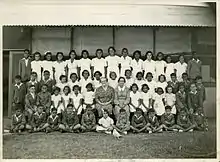St. Mary's Hostel (Alice Springs)
St. Mary's Hostel was an Australian Board of Missions hostel in Alice Springs and, from 1947–1972, it was, in part, an institute for half-caste children and the hostel played an important role in perpetrating the Stolen Generations in Central Australia. Not all of the residents of the hostel were taken from their families and the hostel accommodated many Aboriginal children from more remote parts of the region whose families paid for their stay there.[1]

Background
St. Mary's Hostel was located on the Stuart Highway, just south of Alice Springs, and it was built on the site of the Lady Gowrie Rest Home for Service Women which was in operation during World War II. Following the war it was purchased cheaply by the Australian Board of Missions (higher tenders were received for the property)[2][3] and named St. Mary's Church of England Hostel (most often simply referred to as St. Mary's).[4]
The first superintendent of the hostel, Sister Eileen Heath, arrived in Alice Springs with her friend, Lillian Schroder, who would serve as the housekeeper and seamstress. They welcomed their first residents on 2 March 1946, four children (two girls and two boys) from Newcastle Waters Station and from there the numbers continued to grow. Eight months later there were 18 children.[2]
In January 1949, a major event in the life of the hostel was Heath travelling to Mulgoa NSW, to 'bring back' some of the women and children who had been evacuated there during the war (1942); many of the evacuees chose to stay but Heath made the return journey with 3 children and 9 children and re-settled at St. Mary's.
In 1953 film director Charles Chauvel visited St. Mary's (for the second time) during an exhaustive search for his lead and "discovered" Ngarla Kunoth (Rosalie Kunoth-Monks) who he cast as the title role in Jedda.[2]
Records are available of all residents of St. Mary's in 1953 that give an "undated list of inmates" showing that, of the 71 students, 31 were wards of the Native Affairs Branch. In addition to this, there are 6 "working girls" listed; women who worked in Alice Springs and paid board at the hostel.[5]
The second superintendent of the hostel was Captain, later Reverend, Colin Steep who worked there from 1956 - 1959 and it is he who struck up a friendship with Robert Czakó, a Hungarian artist, who he allowed and supported to paint the Robert Czakó Mural at the onsite chapel. This mural depicts biblical themes and was heritage listed in 2014.[6]
The final two superintendents were Archdeacon Bott (1962 - 1966) and Bob Gaff (1971 - 1972). Bob Gaff continued as superintendent when the home closed and became St Mary's Children's Village.[2]
In 2016 Archbishop Freier claimed that the hostel had been "appropriated" by the post-war government to wrongfully remove children from their families and said that the Anglican Church:
"[R]ecognises the pain and suffering endured by Aboriginal people forcibly removed from their families and apologises for any of our Church policies and actions that have ever contributed, in any way, to that hurt.”
— Archbishop Philip Freier, https://www.anglicanprimate.org.au/2016/08/01/sorrow-and-success-at-st-marys/
St. Mary's Hostel residents
- Freda Glynn, co-founder of CAAMA
- Pat Ansell-Dodds, artist, elder and lecturer
- Rona Glynn, first Indigenous teacher and nurse in Alice Springs
- Rosalie Kunoth-Monks, actress, Aboriginal activist and politician
- Tony Liddle, truck driver and Aboriginal activist
Alternate names
- Mount Blatherskite Hostel
- St Mary's Church of England Home
- St Mary's Home for Children
References
- "St Mary's Hostel (1947 - 1972)". Find and Connect. 2019.
- Petrick, José (2016-07-23). The Robert Czakó Mural, St Mary's family services & beyond. Jeffries, Brian, Canon,, Anglican Church of the Ascension (Alice Springs, N.T.) (3rd revised ed.). Alice Springs, NT. ISBN 9780646959191. OCLC 957733928.
- "Lady Gowrie Hostel At Alice Springs". Advertiser (Adelaide, SA : 1931 - 1954). 1946-03-27. p. 3. Retrieved 2019-11-04.
- Petrick, Jose. (1989). The history of Alice Springs through street names. Petrick, Jose. Alice Springs, N.T.: J. Petrick. ISBN 0731644379. OCLC 27577058.
- "St Mary's Hostel, Alice Springs". www.cifhs.com. Retrieved 2019-11-04.
- "Beloved mural reaches heritage status". www.ntnews.com.au. 2014-01-18. Retrieved 2019-11-04.